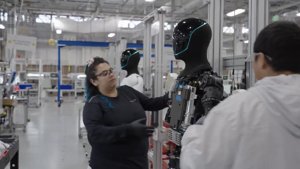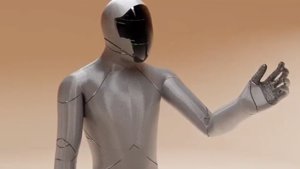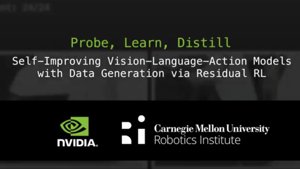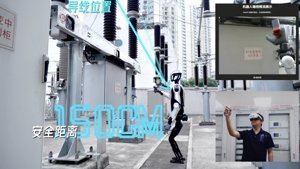When Elon Musk starts doing the robot on stage, you know you’re in for more than your standard quarterly earnings report. Tesla’s 2025 Shareholder Meeting wasn’t merely a sober financial update; it was a full-blown sci-fi manifesto, delivered with the casual swagger of a chap who’d just secured a compensation package sizeable enough to bankroll a small nation. The agenda? A veritable trifecta of world-altering products slated for production next year: the Optimus humanoid robot, the Tesla Semi, and the much-anticipated CyberCab.
The presentation was a relentless torrent of audacious claims, from “eliminating poverty” with robots to, rather controversially, enabling texting while driving. It was a classic Musk masterclass, deftly blurring the lines between visionary roadmap and his infamous reality-distortion field. But beneath the headline-grabbing pronouncements lies a concrete, if utterly stratospheric, plan to pivot Tesla from a mere car company into an unassailable robotics and AI juggernaut.
The Optimus Supremacy: Your Future Butler or, Dare We Say, Overlord?
Forget about merely churning out cars. Musk’s vision for Optimus is nothing short of planetary-scale domination, a proper robot uprising, but in a good way, apparently. He described the humanoid bot as potentially “the biggest product of all time,” predicting that every human will eventually be clamouring for their own personal R2-D2. To that end, Tesla is planning the “fastest production ramp of any large complex manufactured product ever,” kicking off with a one-million-unit production line in Fremont, followed by a whopping ten-million-unit facility in Texas.
The applications, according to Musk, are utterly boundless.
“People often talk about things like eliminating poverty, giving everyone amazing medical care,” he stated. “Well, there’s actually only one way to do that, and that’s with the Optimus robot.”
He went on to claim Optimus will eventually be a better surgeon than any human, boasting precision “that is beyond human.” In a more bizarre aside, he even proposed a “humane form of containment” for criminals, where an Optimus unit would simply shadow them around to prevent future crimes. A personal parole officer bot – what could possibly go wrong, eh?
An Infinite Money Glitch and the Brain Upload Bonanza
The economic implications, in Musk’s estimation, are nothing short of mind-boggling. He referred to Optimus as an “infinite money glitch,” capable of boosting the global economy by a factor of 10 or even 100. It’s a stonkingly bold claim, positioning the robot not just as a mere product, but as a fundamental economic multiplier.
This ambition is, of course, running parallel to the burgeoning humanoid robot race, where competitors are also making rather significant strides. Just last week, XPENG truly made waves with its own increasingly lifelike designs, a cracking story we covered in {< crosslink “xpengs-iron-robot-more-human-than-human” hreflang=“en-gb” >}. The race to create a convincing, capable humanoid is clearly hotting up, and then some.
But the vision, naturally, extends far beyond mere physical labour. When quizzed about the potential for downloading human consciousness into an Optimus body, Musk didn’t so much as bat an eyelid. He suggested that, with the help of Neuralink, creating a “snapshot” of a person’s mind and uploading it to a robot could become a genuine possibility in less than 20 years. Immortality, it seems, is now firmly etched onto the product roadmap.
Meanwhile, Back on the Asphalt…
Lest we forget that Tesla still, rather famously, makes things with wheels, major updates are indeed heading to the automotive lineup. The CyberCab, a purpose-built robotaxi utterly devoid of a steering wheel or pedals, is slated to commence production in April 2026. Musk described its manufacturing process as being closer to that of consumer electronics than traditional cars, aiming for a staggering cycle time of under 10 seconds per vehicle off the line.
This autonomous future is, naturally, powered by Tesla’s next-generation silicon. Musk took a proper pot-shot at the competition, claiming the new in-house AI5 chip would offer performance comparable to an Nvidia Blackwell chip at one-third the power consumption and less than 10% of the cost. “I’m super hardcore on chips right now,” he admitted. “I have chips on the brain. I dream about chips.” A man truly obsessed, then.
Perhaps most controversially, Musk declared that Full Self-Driving (FSD) is becoming so utterly capable that the company is “almost comfortable” allowing people to text and drive. He suggested this feature could be enabled in the next month or two, pending a review of safety statistics, arguing it’s what people want to do anyway. Regulators, one suspects, will have rather a lot to say about that particular “killer app.”
A Triumphant Trifecta of Production
To summarise, Tesla is gearing up for an unprecedented production push in 2026:
- Optimus: Initial production line in Fremont, with a massive 10-million-unit/year factory already planned for Texas.
- CyberCab: Production kicks off in April 2026 in Texas, designed for frankly extreme manufacturing efficiency.
- Tesla Semi: The long-awaited electric truck is also set to enter production next year.
The 2025 shareholder meeting was, without a shadow of a doubt, a dizzying spectacle of ambition. Musk laid out a future where Tesla’s humanoid robots reshape the very fabric of the labour force, its autonomous taxis dominate urban transport, and its AI hardware sets the industry standard. Whether this proves to be a prophetic glimpse into the next decade or merely a masterfully executed performance designed to keep investors captivated remains to be seen. But one thing is absolutely certain: it won’t be boring. Not by a long chalk.






